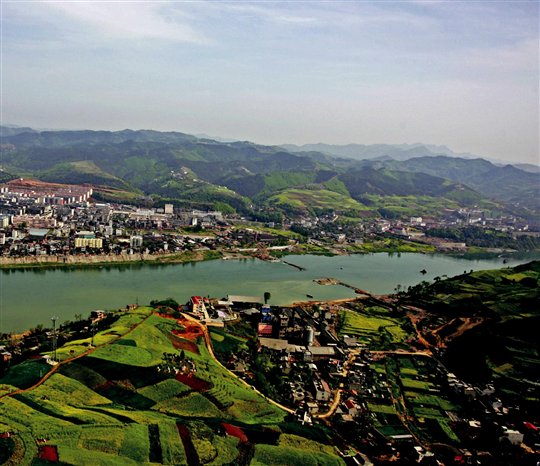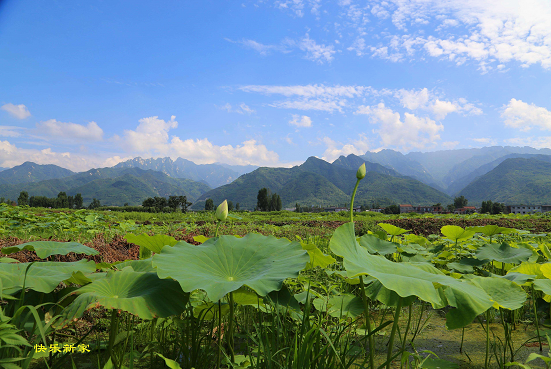Miraculous Qinling Mountains
Among numerous China’s famous mountains, Qinling is neither the tallest nor the longest, but it wins worldwide fame with its uniqueness, outstandingness and miraculousness.

The majestic Qinling Mountains
Qinling can be understood in two senses. Generally Qinling refers to the huge mountains located at the center of China, starting from Gansu Province, going across Shaanxi Province, ending in Henan Province, with the total length of over 1,600km from east to west, the width of dozens of kilometers to two or three hundred kilometers, and the elevation of 1.5km to 2.5km, and its tallest peak, Taibai Mountain, has an elevation of 3.767km. From the narrow sense, Qinling refers to the central section of Qinling Mountains, the part in Shaanxi Province.

According to geological research, Qinling came into being 1 billion to 700 million years ago. The earth was in the stage of chaos at that time. Under the thrust of the earth’s revolving and the interior power of the earth, Northern Laurasialand and Southern Gondwanaland moved together; strenuous crash, squeezing and cohering made the ground between the two geologic plates upheave gradually; with the geologic upheaval and sinking, small and big rivers began to swarm and pour; life came into being when damaging; plants of various varieties began to appear on the suitable ground, which made the ground a wild profusion of vegetation; and Qinling, the great mountains, came into being at the center of Chinese territory. As it were, Qinling came into being during the serious pain and anguish of the ground, but it is the pain and anguish that created the limitless miraculous scenes of Qinling. The mountains are precipitous and full of grandeur there, the water is clear and gentle there, and the combination of mountains and water creates the beauty of Qinling and becomes the source of life of offsprings of the Chinese nation.

The Hanjiang River running along the south side of the Qinling Mountains
Since Qinling is located in the south of Guanzhong Plain in Shaanxi, it was originally called “Southern Mountain” in ancient China. Another statement says the mountain “is located at the center of heaven and south of the capital”, so it was also called “Zhongnan” (literally means “center and south”). Additionally, it was called “Zhongtiao” and “Zhonglong” in a historic book Shangshu · Yugong, compiled in the Warring States Period. These have clearly indicated that through their practical activities, ancient Chinese had the most important geologic and cultural feature of Qinling—lying in the center. In the Warring States Period, Qinling belonged to the territory of the Qin State and was the tallest mountains in Qin, so the name, Qinling, came into being. “Qinling, the biggest obstacle in the world,” said Sima Qian in his work Shiji, and this is earliest seeable record of the name of “Qinling”. Since then, “Qinling” became the most famous and influential name of the mountains which have many names.

In September 1868, Germany geologist Von Richthofen came to China. After traveling around fourteen provinces of China in four years, he began effective geologic investigation at the southern foot of Qinling Mountains. He collected data, fossils and rock ore specimen, drawn topographic map, geologic map and stratigraphic profile. After returning to German, he published a famous geologic work—the five-volume China. Since then, Qinling, with real geologic meaning, made a sensation throughout the world together with the name of Von Richthofen.
At the center of Chinese territory, Qinling are the tallest mountains with west-east run and are the only mountains with east-west run. And it is this reason that creates the outstandingness and miraculousness of Qinling.

In terms of geology, Qinling is the geologic boundary of Southern and Northern China as well as the watershed of the two river systems of Yangtze River and Yellow River. The mountain spring flows from the northern foot of Qinling, forms rivers and pours into the Yellow River, meanwhile, the mountain spring flows from the southern foot of Qinling, vers and pours into the Yangtze River; Weihe River, almost parallels to Qinling and is dozens of kilometers rom Qinling in the north, collects the water poured from f rivers from the northern foot of Qinling, nourishes G hong Plains and creates the beauty and fertility of the 800km Qin territory of Guanzhong Plains.
In terms of climate, Qinling is the watershed of northern subtropical zone and warm temperate zone. As a mountain with east-west run, Qinling is relatively gentle at the south slope, warm and moisture airflow from the south slowly arises here and finally forms rainfall. On the other side of it, steep northern slope stops the cold current coming from the north, and thus, Qinling also becomes the boundary of the Southern and Northern China as well as the boundary of climatic zones. Every fall, the leaves on the northern slope of Qinling begin to wither and fall while the southern slope of Qinling is still covering with a wild profusion of vegetation. Due to the retardation to dry and wet monsoon as well as the water vapor, north subtropical zone with humid climate exists in the southern area of Qinling while warm temperate zone with humid and subhumid climate exists in the northern area of Qinling.

Northern foot of Qinling Mountains
In terms of biology, Qinling is a biological treasure in subtropical zone at the northernmost latitude and also a Chinese biological gene pool with most abundant biological species. It divides animal fauna into palearctic realm and oriental realm. Popularly speaking, the species of the northern foot of Qinling are mostly northern species while those of the southern foot of Qinling are mostly southern species. Qinling has significant difference of natural factors, such as landform, climate, vegetation, etc., in southern and northern areas of Qinling, which causes the complexness and diversity of animal’s living environment. Such institution is greatly rare in the Chinese Mainland and the world. The animals of two different faunas live in the same mountain, which make Qinling a real paradise of animal.
In terms of ecology, Qinling is the most important ecological security barrier area, water resource conservation area as well as forest resource distribution area in central part of China.
In terms of culture, Qinling has unique influence on emergence, development, and flowing deformation of Chinese civilization. Starting from Homo erectus Lantian Ape-man, Qinling breeds the early civilization of China, feeds the glory of the Zhou, Qin, Han, and Tang dynasties, and also witnesses the rough and winding development of the Chinese nation. Simultaneously, Qinling is also the ancient place for “establishing Confucianism and Taoism as well as integrating Buddhism”. It was the three-dimension coordinate of Confucianism, Taoism and Buddhism that built the interior spiritual world of Chinese people and cast the core value of Chinese people. In this sense, Qinling is not only the soul home of Chinese people but also the “Dragon Vein” of Chinese civilization.

Qinling is not only the boundary mountain between the Northern China and Southern China but also the creator and separator of the geologic, climatic and resource difference in the Northern and Southern China. Meanwhile, it is the boundary of the cultural difference of the Northern and Southern China. Its huge and long body blocks the airflows from the Northern China and Southern China, thus there is the cultural difference and diversity. For instance, rainfall mostly distributes in the Southern China while snowfall mostly distributes in the Northern China; boats are more suitable for the Southern China while horses are more suitable for the Northern China; Southerners are gentle in their characters while northerners are bold and unconstrained in their characters, etc. Qinling is not only the watershed between Yangtze River and Yellow River, but also the origin of Hanjiang River and Weihe River, largest tributaries of Yangtze River and Yellow River. It is Hanjiang River and Weihe River, which bring the color and temperament of the southern and northern of Qinling into the whole country. In this sense, Qinling is the integrator of the special resources of the Northern China and Southern China.


